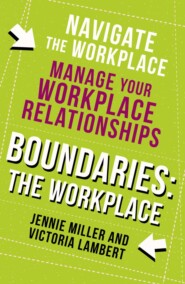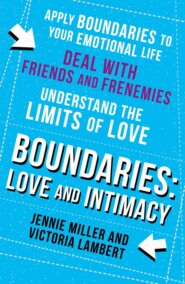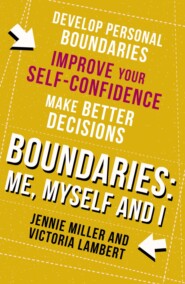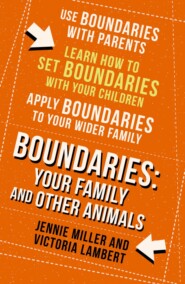По всем вопросам обращайтесь на: info@litportal.ru
(©) 2003-2024.
✖
Boundaries: Say No Without Guilt, Have Better Relationships, Boost Your Self-Esteem, Stop People-Pleasing
Настройки чтения
Размер шрифта
Высота строк
Поля
‘The greatest discovery of all time is that a person can change his future by merely changing his attitude.’
OPRAH WINFREY
It is so important that you care for yourself first before you decide how much you can give to or care for another. Self-care is not selfish or even self-centred – quite the opposite. Remember when you get on a plane how the flight attendants tell you – in the case of emergency – to put on your own oxygen mask first, before helping others?
That’s a practical example of self-care – which is clearly aimed at a wider good. Setting self-boundaries is not about ignoring the needs of others, it’s about not ignoring yourself.
Take a minute to notice your reactions to what you have just read. What are your thoughts and feelings? When you read about the oxygen mask, does that make sense?
Can you think of a recent example of an occasion when you have put yourself first? Perhaps it was having an early night when others expected you to stay up to help or entertain them. Maybe you can’t think of an example, but you may know someone who seems confident in putting their needs first (but whom you don’t think of as selfish). You might view them as ‘sorted’ or ‘in control’. Write these initial thoughts down in your Learning Journal.
In Step One, we will learn to create and/or strengthen our personal boundaries which affect sleep, fitness, unhealthy habits, social media and e-mail and our attitude to our ‘self’ in general. We will also introduce a concept called the ‘Drama Triangle’, which explains how you interact with others.
In Jennie’s clinical practice, many clients come with an array of real problems involving other people – such as spouses or children – but what is often underlying is a lack of self-care and a surprising lack of awareness of their own needs. Encouraging them to focus on themselves first makes it easier to tackle their issues with others.
We all benefit from a bit of time and space to reflect on our lives and ourselves. And this book isn’t a replacement for therapy or suggesting anyone needs it. But Jennie knows from more than twenty years in practice – working all over the UK – there are many recurring personal and emotional issues which boundaries can help with.
Have you ever reflected on your personal rules for life – those that dictate things like our bedtimes, eating habits, manners and attitudes to relationships, which all develop over time. These are our ‘self-boundaries’ – and they primarily affect us (though they may well have a knock-on effect on others).
Here, we’ll be exploring our key self-boundaries and explaining how we can set them, taking into account our practical and emotional needs. This is a holistic approach to life – getting into the habit of caring for ourself in all regards. Treating ourself with respect and kindness will change the way we live, before we even start improving relationships with those around us.
We’re going to put you back in charge of your own life, before we go on to explaining how to use boundaries with others.
EXERCISE: Visualise Your Boundary
Read through the following, then start.
Sitting in a comfy chair, take a few deep breaths and close your eyes. Settle yourself. Notice your breathing throughout the exercise.
Now, picture yourself stood in a large field. It is a beautiful sunny day, with blue sky, birds singing and lush green grass underfoot. Take a good look around your field and notice where you are in the field.
As you stand there, imagine that a boundary appears around you. What does it look like? What is it made of? How wide is it? How tall? Is it the same all the way around? Are there doors or windows? How do you feel within your boundary?
Now, imagine your field is becoming populated first with your family, then friends, then work colleagues, and finally everyone in your life, some closer, some further away. The boundary stays in place, but some may be within it and some outside.
Note again how you feel inside your boundary. Who is near to you, and who is far away?
Then open your eyes.
Go to your Learning Journal and answer these questions (you may want to draw rather than write your response): What does your boundary look like? Can you describe it? How did you feel when you were inside it? Did you feel safe, trapped, or lonely? Was there a difference between how you felt when there was and wasn’t a boundary? What was it like when the other people appeared in your field? What’s your view on your boundary? Does it feel secure? Does it allow you to be in contact with others or is it too rigid?
Are you surprised at your responses? Looking back at this boundary, would you consider it to be good enough? If not, write down what that ‘perfect’ boundary might look like. For example, if the boundary that first came into your mind had a perimeter of barbed wire, would you prefer it to be a natural, more porous hedge? It’s useful to do this exercise and imagine a physical boundary, but don’t worry – this mental picture can and will change as you become more confident of your needs.
So, why do your own boundaries matter in the context of others’ behaviour? Let’s consider Robinson Crusoe, Daniel Defoe’s famous castaway, who chose to live to a routine that helped him – in his own words – ‘stay sane’. With no one around him to impose boundaries, rules, or expectations on him, his survival – and happiness – depended on him making and keeping promises to himself in terms of behaviour.
But how would anyone fare on a desert island with no self-rules? Think of an alternative destination: the location in Lord of the Flies, William Golding’s novel of 1954. In this book, a group of young boys are marooned on an island and must find their own way in order to survive. One of the older boys, Piggy, appeals to reason, ‘Which is better – to have rules and agree, or to hunt and kill? … law and rescue, or hunting and breaking things up?’ But the other children – who don’t display any personal boundaries – do not know how to control their impulses, and soon individual lives and the group’s salvation are threatened.
Which island would you rather live on? One which is governed by good sense, responsible behaviour and self-care or the other, which has the false attraction of there being no boundaries? This feels like the ultimate freedom, but descends in time to anarchy and survival of the fittest.
EXERCISE: The Debating Table
In this exercise, we are going to show you how to identify their ‘self’. Our inner voice or sense of self is multi-faceted. Everyone has competing thoughts, feelings and beliefs which influence their conscious choices; you will have been accumulating these (often without knowing) since birth. Some we take heed of more than others. This exercise is about learning to listen to your whole ‘self’ before you make a decision – not just the voices that shout loudest.
Picture yourself sitting at a favourite table where you might reasonably have a work discussion or family debate. This could be in a boardroom, a kitchen, or even outside in your garden. You are sitting at the head of the table. This is you at your most composed – you are aware of all that is around you, thinking and feeling with conscious good intent.
As an example, we’re going to explore what would happen in the case of a holiday windfall.
You are handed a piece of paper that says that you have won £1,000 to spend on a holiday but you have to decide where you are going within the next hour or the offer will expire.
As you look up from this piece of paper, the table has become populated with others who feel familiar to you. They sit down on all sides and begin to discuss the offer.
Notice that there is a child at the table bouncing up and down and saying, ‘Can we go to the beach, can we go to the beach?’ You feel an excitement in yourself at this response. When was the last time you went to the sea and had a beach holiday? That would be great, you think.
But then a stern voice coming from an older person than yourself sat at the other side of the table says, ‘Well, that sounds a frivolous waste of money. We should put it to good use and go on a cultural trip – I vote for a coach drive across Europe. Think of all the cities we could pack in.’
As the chair of the discussion, you notice the disappointment of the child whose shoulders droop.
‘Driving for hours? Yuck,’ they retort.
To you, the idea of the drive is appealing and yes, it would be a good use of the money you think, but you notice that you don’t feel as excited as at the beach holiday idea.
The older person is talking again: ‘This is a lot of money and shouldn’t be wasted on a beach holiday, this is for the grown-ups to decide.’
Again, you clock the disappointed expression of the child.
But now you notice another child sat very quietly, hands in their lap, looking around at everyone: ‘Please may I say something?’ they say as they put their hand up. You nod encouragement.
They continue, ‘Well, I would like to go on the drive. I know it would be good for me and make everyone else happy.’ The older one nods with approval and the child goes slightly pink with pleasure at this acknowledgement.
The child who wanted to go to the beach bursts into tears. At their shoulder, another child appears and bangs their fists on the table, shouting, ‘It’s not fair, you never listen to me,’ while glaring at the older person.
A soothing voice floats across the table; another older person has appeared. ‘There, there. We will listen to you but not while you are shouting. I like the idea of both holidays but maybe we could find another solution. This shouldn’t be just for us. Who else can we take? I know that Uncle Theo hasn’t had a holiday for ages, so I vote for a city break near a beach and we take Uncle Theo.’
The quiet child’s response: ‘I agree.’
The shouty child’s response: ‘Yuck, I hate Uncle Theo! He smells.’
The beach child’s response: ‘No, thanks. I still vote for beach.’
The first older person’s response: ‘We will decide what’s best; it’s not a decision for children.’
The second older person’s response: ‘Well, we need to find a solution that’s nice for all of us.’
All eyes turn and look at you. ‘What shall we do?’ they say in unison.
Now, think about what you would do in this scenario. What would be your decision? And who has the loudest voice at your table, because this is a metaphor for you and the different ‘selves’ you are made up from.
Now draw your debating table in your Learning Journal.









